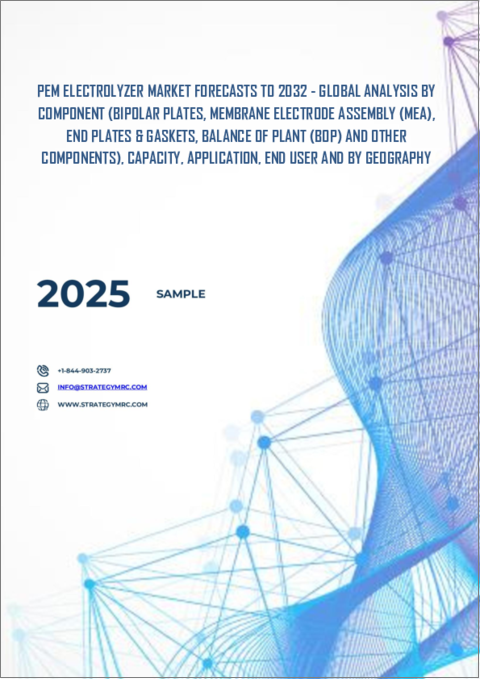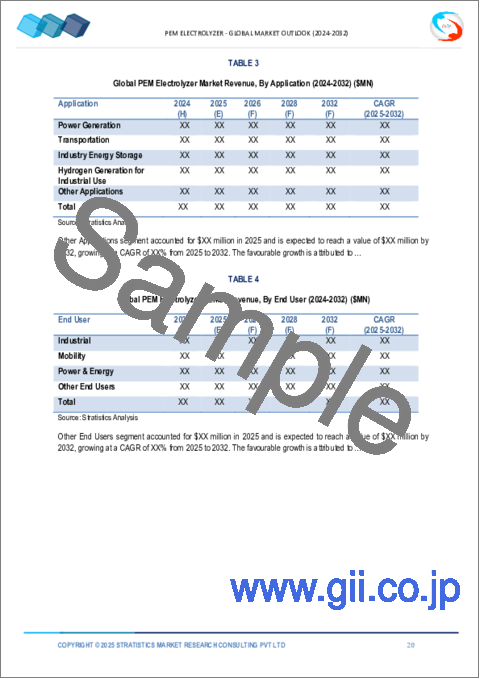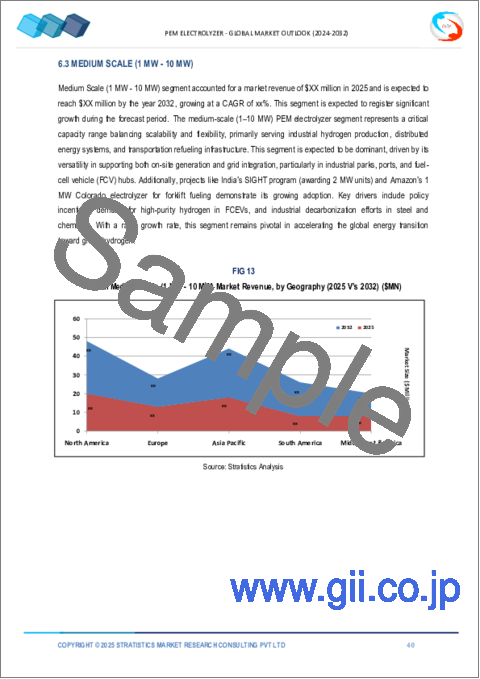|
|
市場調査レポート
商品コード
1716353
PEM電解槽市場の2032年までの予測:コンポーネント別、容量別、用途別、エンドユーザー別、地域別の世界分析PEM Electrolyzer Market Forecasts to 2032 - Global Analysis By Component (Bipolar Plates, Membrane Electrode Assembly (MEA), End Plates & Gaskets, Balance of Plant (BoP) and Other Components), Capacity, Application, End User and By Geography |
||||||
カスタマイズ可能
|
|||||||
| PEM電解槽市場の2032年までの予測:コンポーネント別、容量別、用途別、エンドユーザー別、地域別の世界分析 |
|
出版日: 2025年04月03日
発行: Stratistics Market Research Consulting
ページ情報: 英文 200+ Pages
納期: 2~3営業日
|
全表示
- 概要
- 図表
- 目次
Stratistics MRCによると、PEM電解槽の世界市場は2025年に13億米ドルを占め、2032年には109億米ドルに達し、予測期間中のCAGRは35.5%で成長すると予測されています。
PEM電解槽は、電気エネルギーを利用して電解プロセスを実行し、水をその構成要素である水素と酸素に効果的に分離する装置です。このシステムは、電解質として強力な高分子膜を使用し、ガスを遮断しながらプロトンを通過させる。PEM電解槽は、高効率、高速応答時間、コンパクトな設計で、再生可能エネルギーの統合やグリーン水素の製造に適しています。PEM電解槽の用途は、輸送、産業プロセス、送電網のバランシングに特に適しています。
国際エネルギー機関(IEA)によると、2023年末の世界の電解槽設置容量は140万kWに達し、前年からほぼ倍増しました。プロトン交換膜(PEM)電解槽は、この容量のうち約30万kWを占めています。
高まるグリーン水素需要
グリーン水素の需要は、再生可能エネルギー源への世界の移行と脱炭素化の強調の高まりに後押しされています。太陽や風などの再生可能エネルギーを利用して水を水素と酸素に分解するPEM電解槽は、グリーン水素の製造に不可欠です。輸送、発電、化学産業はすべて、このクリーンな水素に依存しています。グリーン水素は、持続可能なエネルギー転換の重要な要素になりつつあります。これは、水素インフラへの投資を加速させる政府の奨励政策と経済的インセンティブの結果です。
重要材料の入手が困難
大きな問題のひとつは、PEM電解槽に不可欠な材料、すなわちプラチナとイリジウムの不足です。これらの材料は高価で希少であるにもかかわらず、膜電極の構造に不可欠です。この制約の結果、PEM電解槽は製造コストが高くなり、小規模な市場参加者にとっては利用しにくいものとなっています。これらの一般的でない元素への依存はサプライチェーンの脆弱性を生み、コストに敏感な分野でのPEM技術の拡張性をさらに妨げています。
再生可能エネルギーとの統合
PEM電解槽は、再生可能エネルギー源と組み合わせることで、大きな成長の可能性をもたらします。PEM電解槽は、太陽エネルギーや風力エネルギーからの余剰電力を使ってグリーン水素を製造することができ、送電網を安定化させ、二酸化炭素排出量を削減する取り組みを支援することができます。さらに、電解槽技術の向上により、経費が削減され、効果も高まっているため、より幅広い産業での利用が可能になっています。水素発電と再生可能エネルギー発電の相乗効果により、長期的な市場拡大が見込まれています。
政策の不確実性と長期的展望の欠如
一貫性のない規則と、水素導入に関する首尾一貫した長期戦略の欠如が、市場拡大を脅かしています。数多くの政府がグリーン水素プロジェクトに資金を提供しているが、一貫性のない法律や未発達のインフラがその進展を妨げています。また、アルカリ電解のような他の技術との競合が規則をより複雑にしており、PEM電解槽の普及を遅らせる可能性があります。
COVID-19の影響:
サプライチェーンの混乱とプロジェクトのスケジュール遅延により、COVID-19の大流行はPEM電解槽事業に混乱をもたらしました。鉄鋼、化学、石油精製などの主要な水素消費者は、操業停止中の活動を縮小し、電解槽の必要性に影響を与えました。しかし、この伝染病流行は、強固なエネルギー・ネットワークの必要性も浮き彫りにし、景気回復後のクリーン・エネルギー技術投資の復活につながりました。経済が回復するにつれて、持続可能なインフラストラクチャーが重視されるようになり、PEM電解槽はグリーン復興戦略に欠かせないものとなりました。
予測期間中、膜電極接合体(MEA)セグメントが最大となる見込み
膜電極アセンブリ(MEA)セグメントは、予測期間中に最大の市場シェアを占めると予想されます。これは、水素製造時の電気化学プロセスを促進する上で重要な役割を果たすためです。MEAは、白金やイリジウムのような最先端の触媒を統合し、PEMシステムの卓越した効率と耐久性を保証します。輸送や発電などの分野で広く使用されている事実が、MEAの重要性を浮き彫りにしています。さらに、コストを下げながらMEAの性能を向上させるための研究開発の継続的な取り組みが、予測期間中の採用をさらに後押しすると思われます。
産業用水素生成分野は予測期間中最も高いCAGRが見込まれる
予測期間中、産業用水素生成分野が最も高い成長率を示すと予測されます。この成長率は、化学、鉄鋼、アンモニア生産などの産業からの需要が増加していることに起因しています。これらの分野では、グリーン水素が従来の化石燃料に代わる持続可能な代替燃料となり、国際的な脱炭素化目標をサポートします。クリーン技術導入に対する政府のインセンティブも、産業界がグリーン水素ソリューションに切り替えることを後押ししています。このパターンは、産業用途が市場成長にとっていかに重要になっているかを強調しています。
最大のシェアを占める地域:
予測期間中、欧州地域は2050年までにカーボンニュートラルを目指すという強いコミットメントにより、最大の市場シェアを占めると予想されます。このリーダーシップは、欧州連合(EU)によるグリーン水素インフラと再生可能エネルギーへの大規模な投資によって実証されています。輸送網や産業プロセスでPEM電解槽を使用する取り組みは、フランスやドイツなどの国が主導しています。さらに、減税や補助金といった奨励法が、この分野での市場拡大を助長する雰囲気を醸成しています。
CAGRが最も高い地域:
予測期間中、アジア太平洋地域は再生可能エネルギー発電への投資が増加し、発電や輸送を含む最終用途産業全体でグリーン水素への需要が高まっているため、最も高いCAGRを示すと予測されます。この拡大を牽引するのは、官民パートナーシップの助けを借りて野心的な水素計画を実行に移している中国、韓国、日本、インドなどの国々です。さらに、この分野での燃料電池自動車の利用拡大が、PEM電解槽の需要を押し上げています。
無料カスタマイズサービス:
本レポートをご購読のお客様には、以下の無料カスタマイズオプションのいずれかをご利用いただけます:
- 企業プロファイル
- 追加市場企業の包括的プロファイリング(3社まで)
- 主要企業のSWOT分析(3社まで)
- 地域セグメンテーション
- 顧客の関心に応じた主要国の市場推計・予測・CAGR(注:フィージビリティチェックによる)
- 競合ベンチマーキング
- 製品ポートフォリオ、地理的プレゼンス、戦略的提携に基づく主要企業のベンチマーキング
目次
第1章 エグゼクティブサマリー
第2章 序文
- 概要
- ステークホルダー
- 調査範囲
- 調査手法
- データマイニング
- データ分析
- データ検証
- 調査アプローチ
- 調査資料
- 1次調査資料
- 2次調査情報源
- 前提条件
第3章 市場動向分析
- 促進要因
- 抑制要因
- 機会
- 脅威
- 用途分析
- エンドユーザー分析
- 新興市場
- COVID-19の影響
第4章 ポーターのファイブフォース分析
- 供給企業の交渉力
- 買い手の交渉力
- 代替品の脅威
- 新規参入業者の脅威
- 競争企業間の敵対関係
第5章 世界のPEM電解槽市場:コンポーネント別
- バイポーラプレート
- 膜電極接合体(MEA)
- プロトン交換膜(PEM)
- 電極
- ガス拡散層
- 触媒
- イリジウムベース
- プラチナベース
- エンドプレートとガスケット
- バランス・オブ・プラント(BoP)
- その他のコンポーネント
第6章 世界のPEM電解槽市場:容量別
- 小規模(<1 MW)
- 中規模(1MW~10MW)
- 大規模(>10 MW)
第7章 世界のPEM電解槽市場:用途別
- 発電
- 輸送機関
- 産業用エネルギー貯蔵
- 産業用水素生成
- その他の用途
第8章 世界のPEM電解槽市場:エンドユーザー別
- 産業
- 化学薬品
- 石油化学
- 肥料
- 鉄鋼・金属
- モビリティ
- 燃料電池車
- 航空宇宙および海洋
- 電力とエネルギー
- その他のエンドユーザー
第9章 世界のPEM電解槽市場:地域別
- 北米
- 米国
- カナダ
- メキシコ
- 欧州
- ドイツ
- 英国
- イタリア
- フランス
- スペイン
- その他欧州
- アジア太平洋
- 日本
- 中国
- インド
- オーストラリア
- ニュージーランド
- 韓国
- その他アジア太平洋地域
- 南米
- アルゼンチン
- ブラジル
- チリ
- その他南米
- 中東・アフリカ
- サウジアラビア
- アラブ首長国連邦
- カタール
- 南アフリカ
- その他中東とアフリカ
第10章 主な発展
- 契約、パートナーシップ、コラボレーション、ジョイントベンチャー
- 買収と合併
- 新製品発売
- 事業拡大
- その他の主要戦略
第11章 企業プロファイリング
- Plug Power Inc.
- Nel ASA
- Cummins Inc.
- ITM Power PLC
- Hitachi Zosen Corporation
- Elogen
- Siemens Energy AG
- Ningbo Vet Energy Technology Co., Ltd.
- Ohmium International, Inc.
- Hystar
- H-TEC SYSTEMS GmbH
- Bloom Energy Corporation
- McPhy Energy S.A.
- Giner Inc.
- Areva H2Gen
- Thyssenkrupp Nucera
- Proton On-Site
List of Tables
- Table 1 Global PEM Electrolyzer Market Outlook, By Region (2024-2032) ($MN)
- Table 2 Global PEM Electrolyzer Market Outlook, By Component (2024-2032) ($MN)
- Table 3 Global PEM Electrolyzer Market Outlook, By Bipolar Plates (2024-2032) ($MN)
- Table 4 Global PEM Electrolyzer Market Outlook, By Membrane Electrode Assembly (MEA) (2024-2032) ($MN)
- Table 5 Global PEM Electrolyzer Market Outlook, By Proton Exchange Membrane (PEM) (2024-2032) ($MN)
- Table 6 Global PEM Electrolyzer Market Outlook, By Electrodes (2024-2032) ($MN)
- Table 7 Global PEM Electrolyzer Market Outlook, By Gas Diffusion Layers (2024-2032) ($MN)
- Table 8 Global PEM Electrolyzer Market Outlook, By Catalyst (2024-2032) ($MN)
- Table 9 Global PEM Electrolyzer Market Outlook, By End Plates & Gaskets (2024-2032) ($MN)
- Table 10 Global PEM Electrolyzer Market Outlook, By Balance of Plant (BoP) (2024-2032) ($MN)
- Table 11 Global PEM Electrolyzer Market Outlook, By Other Components (2024-2032) ($MN)
- Table 12 Global PEM Electrolyzer Market Outlook, By Capacity (2024-2032) ($MN)
- Table 13 Global PEM Electrolyzer Market Outlook, By Small Scale (< 1 MW) (2024-2032) ($MN)
- Table 14 Global PEM Electrolyzer Market Outlook, By Medium Scale (1 MW - 10 MW) (2024-2032) ($MN)
- Table 15 Global PEM Electrolyzer Market Outlook, By Large Scale (> 10 MW) (2024-2032) ($MN)
- Table 16 Global PEM Electrolyzer Market Outlook, By Application (2024-2032) ($MN)
- Table 17 Global PEM Electrolyzer Market Outlook, By Power Generation (2024-2032) ($MN)
- Table 18 Global PEM Electrolyzer Market Outlook, By Transportation (2024-2032) ($MN)
- Table 19 Global PEM Electrolyzer Market Outlook, By Industry Energy Storage (2024-2032) ($MN)
- Table 20 Global PEM Electrolyzer Market Outlook, By Hydrogen Generation for Industrial Use (2024-2032) ($MN)
- Table 21 Global PEM Electrolyzer Market Outlook, By Other Applications (2024-2032) ($MN)
- Table 22 Global PEM Electrolyzer Market Outlook, By End User (2024-2032) ($MN)
- Table 23 Global PEM Electrolyzer Market Outlook, By Industrial (2024-2032) ($MN)
- Table 24 Global PEM Electrolyzer Market Outlook, By Chemical (2024-2032) ($MN)
- Table 25 Global PEM Electrolyzer Market Outlook, By Petrochemical (2024-2032) ($MN)
- Table 26 Global PEM Electrolyzer Market Outlook, By Fertilizer (2024-2032) ($MN)
- Table 27 Global PEM Electrolyzer Market Outlook, By Steel & Metal (2024-2032) ($MN)
- Table 28 Global PEM Electrolyzer Market Outlook, By Mobility (2024-2032) ($MN)
- Table 29 Global PEM Electrolyzer Market Outlook, By Fuel Cell Vehicles (2024-2032) ($MN)
- Table 30 Global PEM Electrolyzer Market Outlook, By Aerospace & Marine (2024-2032) ($MN)
- Table 31 Global PEM Electrolyzer Market Outlook, By Power & Energy (2024-2032) ($MN)
- Table 32 Global PEM Electrolyzer Market Outlook, By Other End Users (2024-2032) ($MN)
Note: Tables for North America, Europe, APAC, South America, and Middle East & Africa Regions are also represented in the same manner as above.
According to Stratistics MRC, the Global PEM Electrolyzer Market is accounted for $1.3 billion in 2025 and is expected to reach $10.9 billion by 2032, growing at a CAGR of 35.5% during the forecast period. A PEM electrolyzer is a device that utilizes electrical energy to perform the electrolysis process, effectively separating water into its constituent elements, hydrogen and oxygen. The system uses a strong polymer membrane as the electrolyte, allowing protons to pass through while blocking gases. PEM electrolyzers exhibit high efficiency, rapid response times, and a compact design, making them suitable for the integration of renewable energy and the production of green hydrogen. Their applications are particularly relevant in transportation, industrial processes, and grid balancing.
According to the International Energy Agency (IEA), globally installed electrolyzer capacity reached 1.4 GW at the end of 2023, nearly doubling from the previous year. Proton Exchange Membrane (PEM) electrolyzers accounted for approximately 300 MW of this capacity.
Market Dynamics:
Driver:
Growing demand for green hydrogen
The demand for green hydrogen is being driven by the global move toward renewable energy sources and the growing emphasis on decarbonization. PEM electrolyzers, which use renewable energy sources like sun and wind to split water into hydrogen and oxygen, are essential to the production of green hydrogen. Transportation, power generation, and chemical industries all depend on this clean hydrogen. Green hydrogen is becoming a key component of sustainable energy transitions as a result of encouraging government policies and financial incentives that are speeding up investments in hydrogen infrastructure.
Restraint:
Limited availability of critical materials
One major issue is the lack of essential materials for PEM electrolyzers, namely platinum and iridium. Despite being costly and scarce, these materials are essential for the membrane electrode construction. PEM electrolyzers are more costly to manufacture as a result of this restriction, making them less accessible to smaller market players. The dependence on these uncommon elements creates supply chain vulnerabilities, further hindering PEM technology's scalability in cost-sensitive sectors.
Opportunity:
Integration with renewable energy sources
PEM electrolyzers provide a substantial growth potential when combined with renewable energy sources. PEM electrolyzers can produce green hydrogen using extra electricity from solar and wind energy, helping to stabilize the power grid and support efforts to reduce carbon emissions. Furthermore, improvements in electrolyzer technology are lowering expenses and increasing effectiveness, allowing for wider industry usage. Long-term market expansion is anticipated due to the synergy between hydrogen generation and renewable energy.
Threat:
Policy uncertainty and lack of long-term vision
Inconsistent rules and a lack of a coherent long-term strategy for hydrogen adoption threaten market expansion. Numerous governments are funding green hydrogen projects, but inconsistent laws and underdeveloped infrastructure hinder their advancement. Also, competition from other technologies like alkaline electrolysis makes the rules more complicated and could delay the widespread use of PEM electrolyzers.
Covid-19 Impact:
Due to supply chain disruptions and project timeline delays, the COVID-19 pandemic caused disruptions in the PEM electrolyzer business. Key hydrogen consumers like steel, chemicals, and oil refining saw a reduction in activities during lockdowns, which affected the need for electrolyzers. But the epidemic also highlighted the necessity of robust energy networks, which led to a resurgence of clean energy technology investments after the recovery. The emphasis on sustainable infrastructure increased as economies recovered, making PEM electrolyzers essential parts of green recovery strategies.
The membrane electrode assembly (MEA) segment is expected to be the largest during the forecast period
The membrane electrode assembly (MEA) segment is expected to account for the largest market share during the forecast period. This is due to its crucial role in facilitating electrochemical processes during hydrogen production. MEAs integrate cutting-edge catalysts like platinum and iridium to guarantee outstanding efficiency and durability in PEM systems. The fact that sectors such as transportation and electricity generation widely use them highlights their relevance. Furthermore, continued R&D efforts to enhance MEA performance while lowering costs will further support their adoption during the projection period.
The hydrogen generation for industrial use segment is expected to have the highest CAGR during the forecast period
Over the forecast period, the hydrogen generation for industrial use segment is predicted to witness the highest growth rate. This growth rate is attributed to the increasing demand from industries such as chemicals, steel, and ammonia production. In these sectors, green hydrogen provides a sustainable substitute for conventional fossil fuels that supports international decarbonization objectives. Government incentives for clean technology adoption are also encouraging industries to switch to green hydrogen solutions. This pattern emphasizes how crucial industrial applications are becoming to market growth.
Region with largest share:
During the forecast period, the Europe region is expected to hold the largest market share due to its strong commitment to becoming carbon neutral by 2050. This leadership is demonstrated by the European Union's large investments in green hydrogen infrastructure and renewable energy initiatives. Initiatives to use PEM electrolyzers in transportation networks and industrial processes are being led by nations like France and Germany. Additionally, encouraging laws like tax breaks and subsidies fosters an atmosphere that is conducive to market expansion in this area.
Region with highest CAGR:
Over the forecast period, the Asia Pacific region is anticipated to exhibit the highest CAGR because of increased investments in renewable energy and growing demand for green hydrogen across end-use industries, including power generation and transportation. Leading this expansion are nations like China, South Korea, Japan, and India, which are putting ambitious hydrogen plans into action with the help of public-private partnerships. Furthermore, the growing use of fuel cell cars in this area is driving up demand for PEM electrolyzers.
Key players in the market
Some of the key players in PEM Electrolyzer Market include Plug Power Inc., Nel ASA, Cummins Inc., ITM Power PLC, Hitachi Zosen Corporation, Elogen, Siemens Energy AG, Ningbo Vet Energy Technology Co., Ltd., Ohmium International, Inc., Hystar, H-TEC SYSTEMS GmbH, Bloom Energy Corporation, McPhy Energy S.A., Giner Inc., Areva H2Gen, Thyssenkrupp Nucera, and Proton On-Site.
Key Developments:
In January 2025, Plug Power Inc., a global leader in comprehensive hydrogen solutions for the green hydrogen economy, today announced a landmark purchase agreement with Allied Green Ammonia (AGA). This agreement will see Plug supplying an impressive three gigawatts (GW) of electrolyzer capacity to AGA's state-of-the-art green hydrogen-to-ammonia plant, currently under development in Australia. In a significant step towards a clean energy future, AGA will install a 4.5 GW solar plant to power the Plug electrolyzers with zero emission clean electricity. The green hydrogen produced will be used to make green ammonia. With the agreement now signed and sealed, Plug will develop a Basic Engineering and Design Package (BEDP), providing crucial technical details and engineering specifications to attract investors and finalize financing.
In October 2024, Nel's expanded and automated PEM manufacturing facility in Wallingford, Connecticut, was officially opened by Senator Richard Blumenthal. The new facility will have the capacity to produce 10 times as many PEM electrolysers at 30% lower cost than the old factory.
In May 2024, Nel Hydrogen Electrolyser AS, a fully owned subsidiary of Nel ASA has entered into a technology licensing agreement with Reliance Industries Limited (RIL). The agreement provides RIL with an exclusive license for Nel's alkaline electrolysers in India and also allows RIL to manufacture Nel's alkaline electrolysers for captive purposes globally.
Components Covered:
- Bipolar Plates
- Membrane Electrode Assembly (MEA)
- End Plates & Gaskets
- Balance of Plant (BoP)
- Other Components
Capacities Covered:
- Small Scale (< 1 MW)
- Medium Scale (1 MW - 10 MW)
- Large Scale (> 10 MW)
Applications Covered:
- Power Generation
- Transportation
- Industry Energy Storage
- Hydrogen Generation for Industrial Use
- Other Applications
End Users Covered:
- Industrial
- Mobility
- Power & Energy
- Other End Users
Regions Covered:
- North America
- US
- Canada
- Mexico
- Europe
- Germany
- UK
- Italy
- France
- Spain
- Rest of Europe
- Asia Pacific
- Japan
- China
- India
- Australia
- New Zealand
- South Korea
- Rest of Asia Pacific
- South America
- Argentina
- Brazil
- Chile
- Rest of South America
- Middle East & Africa
- Saudi Arabia
- UAE
- Qatar
- South Africa
- Rest of Middle East & Africa
What our report offers:
- Market share assessments for the regional and country-level segments
- Strategic recommendations for the new entrants
- Covers Market data for the years 2024, 2025, 2026, 2028, and 2032
- Market Trends (Drivers, Constraints, Opportunities, Threats, Challenges, Investment Opportunities, and recommendations)
- Strategic recommendations in key business segments based on the market estimations
- Competitive landscaping mapping the key common trends
- Company profiling with detailed strategies, financials, and recent developments
- Supply chain trends mapping the latest technological advancements
Free Customization Offerings:
All the customers of this report will be entitled to receive one of the following free customization options:
- Company Profiling
- Comprehensive profiling of additional market players (up to 3)
- SWOT Analysis of key players (up to 3)
- Regional Segmentation
- Market estimations, Forecasts and CAGR of any prominent country as per the client's interest (Note: Depends on feasibility check)
- Competitive Benchmarking
- Benchmarking of key players based on product portfolio, geographical presence, and strategic alliances
Table of Contents
1 Executive Summary
2 Preface
- 2.1 Abstract
- 2.2 Stake Holders
- 2.3 Research Scope
- 2.4 Research Methodology
- 2.4.1 Data Mining
- 2.4.2 Data Analysis
- 2.4.3 Data Validation
- 2.4.4 Research Approach
- 2.5 Research Sources
- 2.5.1 Primary Research Sources
- 2.5.2 Secondary Research Sources
- 2.5.3 Assumptions
3 Market Trend Analysis
- 3.1 Introduction
- 3.2 Drivers
- 3.3 Restraints
- 3.4 Opportunities
- 3.5 Threats
- 3.6 Application Analysis
- 3.7 End User Analysis
- 3.8 Emerging Markets
- 3.9 Impact of Covid-19
4 Porters Five Force Analysis
- 4.1 Bargaining power of suppliers
- 4.2 Bargaining power of buyers
- 4.3 Threat of substitutes
- 4.4 Threat of new entrants
- 4.5 Competitive rivalry
5 Global PEM Electrolyzer Market, By Component
- 5.1 Introduction
- 5.2 Bipolar Plates
- 5.3 Membrane Electrode Assembly (MEA)
- 5.3.1 Proton Exchange Membrane (PEM)
- 5.3.2 Electrodes
- 5.3.3 Gas Diffusion Layers
- 5.3.4 Catalyst
- 5.3.4.1 Iridium-Based
- 5.3.4.2 Platinum-Based
- 5.4 End Plates & Gaskets
- 5.5 Balance of Plant (BoP)
- 5.6 Other Components
6 Global PEM Electrolyzer Market, By Capacity
- 6.1 Introduction
- 6.2 Small Scale (< 1 MW)
- 6.3 Medium Scale (1 MW - 10 MW)
- 6.4 Large Scale (> 10 MW)
7 Global PEM Electrolyzer Market, By Application
- 7.1 Introduction
- 7.2 Power Generation
- 7.3 Transportation
- 7.4 Industry Energy Storage
- 7.5 Hydrogen Generation for Industrial Use
- 7.6 Other Applications
8 Global PEM Electrolyzer Market, By End User
- 8.1 Introduction
- 8.2 Industrial
- 8.2.1 Chemical
- 8.2.2 Petrochemical
- 8.2.3 Fertilizer
- 8.2.4 Steel & Metal
- 8.3 Mobility
- 8.3.1 Fuel Cell Vehicles
- 8.3.2 Aerospace & Marine
- 8.4 Power & Energy
- 8.5 Other End Users
9 Global PEM Electrolyzer Market, By Geography
- 9.1 Introduction
- 9.2 North America
- 9.2.1 US
- 9.2.2 Canada
- 9.2.3 Mexico
- 9.3 Europe
- 9.3.1 Germany
- 9.3.2 UK
- 9.3.3 Italy
- 9.3.4 France
- 9.3.5 Spain
- 9.3.6 Rest of Europe
- 9.4 Asia Pacific
- 9.4.1 Japan
- 9.4.2 China
- 9.4.3 India
- 9.4.4 Australia
- 9.4.5 New Zealand
- 9.4.6 South Korea
- 9.4.7 Rest of Asia Pacific
- 9.5 South America
- 9.5.1 Argentina
- 9.5.2 Brazil
- 9.5.3 Chile
- 9.5.4 Rest of South America
- 9.6 Middle East & Africa
- 9.6.1 Saudi Arabia
- 9.6.2 UAE
- 9.6.3 Qatar
- 9.6.4 South Africa
- 9.6.5 Rest of Middle East & Africa
10 Key Developments
- 10.1 Agreements, Partnerships, Collaborations and Joint Ventures
- 10.2 Acquisitions & Mergers
- 10.3 New Product Launch
- 10.4 Expansions
- 10.5 Other Key Strategies
11 Company Profiling
- 11.1 Plug Power Inc.
- 11.2 Nel ASA
- 11.3 Cummins Inc.
- 11.4 ITM Power PLC
- 11.5 Hitachi Zosen Corporation
- 11.6 Elogen
- 11.7 Siemens Energy AG
- 11.8 Ningbo Vet Energy Technology Co., Ltd.
- 11.9 Ohmium International, Inc.
- 11.10 Hystar
- 11.11 H-TEC SYSTEMS GmbH
- 11.12 Bloom Energy Corporation
- 11.13 McPhy Energy S.A.
- 11.14 Giner Inc.
- 11.15 Areva H2Gen
- 11.16 Thyssenkrupp Nucera
- 11.17 Proton On-Site






